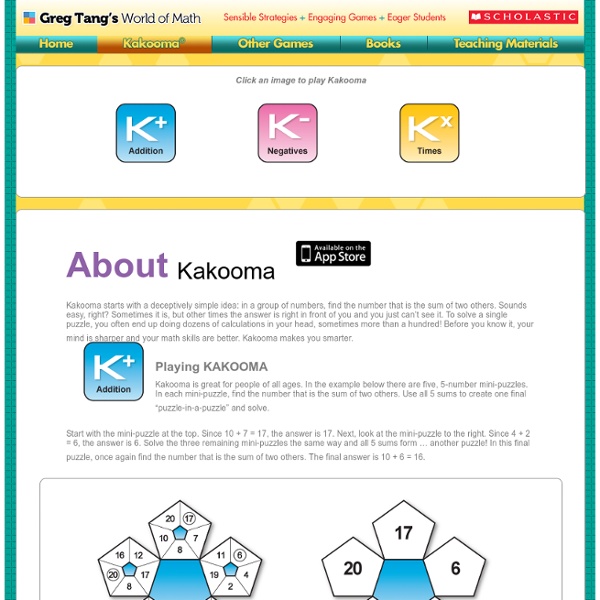XtraMath
Math Chimp Blog | Educational Games and Online Resources
While they are in 5th grade, some of them are not capable of teaching themselves to take on math, as noted by The Globe and Mail. For teachers, what makes the situation worse is that most students suffer from “Math Block,” wherein they develop a passive attitude towards the subject. Fortunately, mobile technology and gamification are here to save the day. In fact, Verizon notes that turning math lessons into games gives students the motivation and energy to master any subject. 1. Factor Samurai employs the similar gameplay of Fruit Ninja, while educating kids the basics of prime factorization. 2. According to the app description, Match Up Math helps students practice the four fundamental operations: Multiplication, Division, Addition, and Subtraction. 3. While teaching fractions and decimals, Chicken Coop Fractions injects an entertaining approach, as two chickens named Henriette and Gudhen fire eggs at the number line. 4. 5. 5th Grade Splash Math Worksheets Game About the Author
Algebra - Elementary Algebra - Homework Help
Can I take a course at HippoCampus for credit? How do I enroll in a course at HippoCampus? Are there any fees to take your courses? How do I make a comment or ask a question? How do I get individual help with my homework assignment? What are the preferred texts? How can I use HippoCampus in my classroom? How can I use HippoCampus in my home school? Can I use the resources you have available for my homeschoolers? Do you know of any wet lab resources to accompany HippoCampus content? Is there a script, app, or something that can be used to track student use of HippoCampus? Can I share my HippoCampus content with my fellow teachers? Can I download the video? Can I change the size of the video window? Why won't the Environmental Science animations play? What if my page scroll bars or "submit" button are not showing? I can't find closed captioning. Where does the content from your site come from? There is an error in the multimedia presentation. How do I report a course errata item? No. AP Course Ledger
Visual Fractions - A Fraction Tutorial
Welcome to Seeing Statistics
Simulations Lesson Plans Reviewed by Teachers
Why Select Other Criteria? Sometimes you only have 45 minutes to review participles before Tuesday's assembly, or you need curriculum you know was reviewed after a certain date. Duration: If curriculum authors indicate how long it takes to implement a resource, i.e. a 30-minute vocabulary exercise, a three-day science experiment, or a two-week expository writing project, we note it for you. If not, our teacher reviewers may indicate an estimated amount of time it would take. When you select a duration in this box, you'll see only resources with that stated duration. Reviewed After: Limit the resources you see to those reviewed since the date you choose by clicking the box and making a selection.
Absolute Value
Absolute Value The concept of absolute value has many uses, but you probably won't see anything interesting for a few more classes yet. There is a technical definition for absolute value, but you could easily never need it. For now, you should view the absolute value of a number as its distance from zero. Let's look at the number line: The absolute value of x, denoted "| x |" (and which is read as "the absolute value of x"), is the distance of x from zero. Warning: The absolute-value notation is bars, not parentheses or brackets. It is important to note that the absolute value bars do NOT work in the same way as do parentheses. Simplify –| –3 |. Given –| –3 |, I first handle the absolute value part, taking the positive and converting the absolute value bars to parentheses: Now I can take the negative through the parentheses: As this illustrates, if you take the negative of an absolute value, you will get a negative number for your answer. Here are some more sample simplifications:
Algebra
The word "algebra" is a distortion of the Arabic title of a treatise by al-Khwārizmī about algebraic methods. In modern usage, algebra has several meanings. One use of the word "algebra" is the abstract study of number systems and operations within them, including such advanced topics as groups, rings, invariant theory, and cohomology. This is the meaning mathematicians associate with the word "algebra." When there is the possibility of confusion, this field of mathematics is often referred to as abstract algebra. The word "algebra" can also refer to the "school algebra" generally taught in American middle and high schools. Finally, the word is used in a third way, not as a subject area but as a particular type of algebraic structure. over a field with a multiplication. and must satisfy An algebra is sometimes implicitly assumed to be associative or to possess a multiplicative identity.
Math Playground - Online Math Games that Give your Brain a Workout
MISTM - Maine's Impact Study of Technology in Mathematics
Maine's Impact Study of Technology in Mathematics (MISTM) was a federally funded collaboration among the Maine Learning Technology Initiative (MLTI) through the Maine Department of Education (DOE), Maine Education Policy Research Institute (MEPRI) and Education Development Center (EDC) in Newton, MA designed to examine the influence of a technology-infused professional development program for 7th and 8th grade mathematics teachers on the mathematics achievement of rural middle school students in technology-rich classrooms. The core goal of the professional development program was to enable grade 7 and 8 teachers and their students in low-performing rural schools to take full advantage of universal laptop availability to enhance mathematics teaching and learning and improve student achievement in mathematics. The primary standards and indicators that were targeted in the intervention were from Cluster 1 and 3 of the Maine Learning Results. Technical Requirements to Use this MISTM CD



